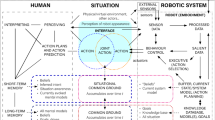Abstract
As humanoid social robots are developed rapidly in recent years and experimented in social situations, comparing them to humans provides insights into practical as well as philosophical concerns. This study uses the theoretical framework of communication constraints, derived in human–human communication research, to compare whether people apply social-oriented constraints and task-oriented constraints differently to human targets versus humanoid social robot targets. A total of 230 students from the University of Hawaii at Manoa participated in the study. The participants completed a questionnaire, which determined their concern for the five communication constraints (feelings, non-imposition, disapproval, clarity, and effectiveness) in situations involving humans or robots. The results show people were more concerned with avoiding hurting the human’s feelings, avoiding inconveniencing the human interactive partner, and avoiding being disliked by the human and less concerned with avoiding hurting the robot’s feelings, avoiding inconveniencing the robot partner, and avoiding being disliked by the robot. But people did not differ in their concerns of the two task-oriented constraints (clarity and effectiveness) in response to humans versus humanoid robots. The results of the research suggest that people are more likely to emphasize the social-oriented constraints in communication with humans.
Similar content being viewed by others
References
Better than people (2005, December 24) The Economist 377(8458):58–59
Breazeal C (2002) Designing sociable robots. MIT Press, Cambridge, MA
Brown P, Levinson S (1987) Politeness: some universals in language usage. Cambridge University Press, Cambridge
Burke JL, Murphy RR, Coovert MD, Riddle DL (2004) Moonlight in Miami: a field study of human–robot interaction in the context of an urban search and rescue disaster response training exercise. Hum Comput Interact 19:25–59
effectiveness (n.d.) The American Heritage® Dictionary of the English Language, Fourth Edition. Retrieved March 05, 2007, from http://dictionary.reference.com/browse/effectiveness
Ferguson CA (1976) The structure and use of politeness formulas. Lang Soc 5:137–151
Gong L (2008) The boundary of racial prejudice: comparing preferences for computer-synthesized white, black, and robot characters. Comput Hum Behav 24:2074–2093
Haslam N (2006) Dehumanization: an integrative review. Pers Soc Psychol Rev 10(3):252–264
Hinds PJ, Roberts TL, Jones H (2004) Whose job is it anyway? A study of human robot interaction in a collaborative task. Hum Comput Interact 19:151–181
Hornyak T (2006) Android science. Sci Am 294(5):32–34
imposition (n.d.) The American Heritage® Dictionary of the English Language, Fourth Edition. Retrieved March 04, 2007, from http://dictionary.reference.com/browse/imposition
Kanda T, Hirano T, Eaton D, Ishiguro H (2004) Interactive robots as social partners and peer tutors for children: a field trial. Hum Comput Interact 19:61–84
Kim MS (1994) Cross-cultural comparisons of the perceived importance of conversational constraints. Hum Commun Res 21:128–151
Kim TG (2006a, May 4) Korean scientists develop female android. The Korean Times. Retrieved March 4, 2007, from http://times.hankooki.com/
Kim YS (2006b, October 18) Female robot walks, talks, and sings. The Korean Times. Retrieved March 4, 2007, from http://times.hankooki.com/
Leary MR, Kowalski RM (1990) Impression management: a literature review and two component model. Psychol Bull 107(1):34–47
Marks P (2001) Toying with the future. Comput Aided Eng 20(4):8–9
Nomura T, Kanda T, Suzuki T, Kato K (2005) People’s assumptions about robots: investigation of their relationships with attitudes and emotions toward robots. In: Proceedings of the IEEE workshop on robots and human interactive communication, Nashville, TN, pp 125–130
Nomura T, Kanda T, Suzuki T (2006) Experimental investigation into influences of negative attitude toward robots on human–robot interaction. AI Soc 20(2):138–150
Oetzel JG, Ting-Toomey S (2003) Face concerns in interpersonal conflict: a cross-cultural empirical test of the face negotiation theory. Commun Res 30(6):599–624
Pineau J, Montemerlo M, Pollack M, Roy N, Thrun S (2003) Towards robotic assistants in nursing homes: challenges and results. Rob Auton Syst 42:271–281
politeness (n.d.) The American Heritage® Dictionary of the English Language, Fourth Edition. Retrieved March 04, 2007, from http://dictionary.reference.com/browse/politeness/
clarity (n.d.) WordNet® 2.1. Retrieved March 05, 2007, from http://dictionary.reference.com/browse/clarity
Thrun S (2004) Toward a framework for human–robot interaction. Hum Comput Interact 19:9–24
Woods S (2006) Exploring the design space of robots: children’s perspectives. Interact Comput 18(6):1390–1418
Young RM (1999) Using Grice’s maxim of quantity to select the content of plan descriptions. Artif Intell 115(2):215–256
Author information
Authors and Affiliations
Corresponding author
Rights and permissions
About this article
Cite this article
Kim, MS., Sur, J. & Gong, L. Humans and humanoid social robots in communication contexts. AI & Soc 24, 317–325 (2009). https://doi.org/10.1007/s00146-009-0224-3
Received:
Accepted:
Published:
Issue Date:
DOI: https://doi.org/10.1007/s00146-009-0224-3




